Over the first two weeks of June I was (mostly) in Ireland - my fourth trip to the Emerald Isle - during which time I also undertook a side trip for a few days to Northern England to visit several cave sites I had not seen in previous visits.
MARBLE ARCH CAVES
There are five show caves open in Ireland, all of which I had visited previously (Henderson 1993, 1997). By and large, with a few exceptions, cave management in Ireland is of a good standard, and certainly superior to that in England, or Europe (Henderson 1987, 1993). On this occasion I had time to re-visit one cave location - The Marble Arch Caves. Marble Arch is located just inside Northern Ireland in County Fermanagh, and is managed by ACKMA member, Richard Watson.
Being unsure if I would have time to get there from my base in Dublin, I did not pre-advise Richard of my potential arrival, but as it turned out I had a day to spare, so I promptly hired a car and sped up the road.
Naturally, Richard was most surprised to see me when I arrived - pleasantly surprised, I think! He very kindly dropped everything, and we spent a number of hours 'doing the rounds'. First up was a trip through Marble Arch Cave, of course!
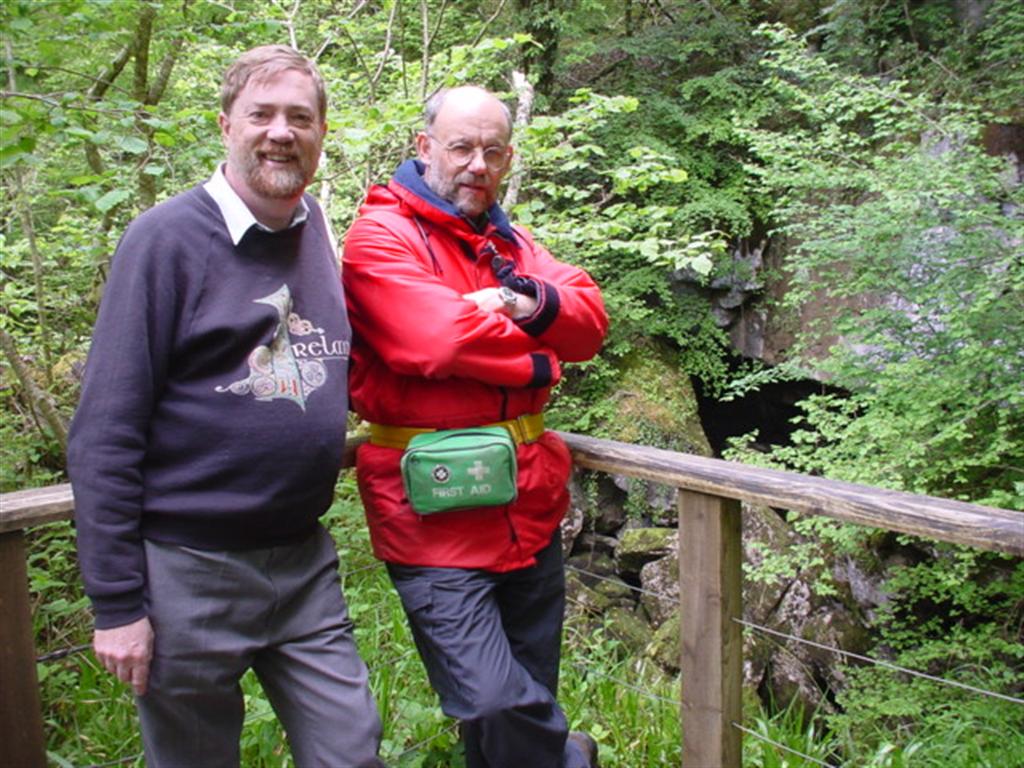 |
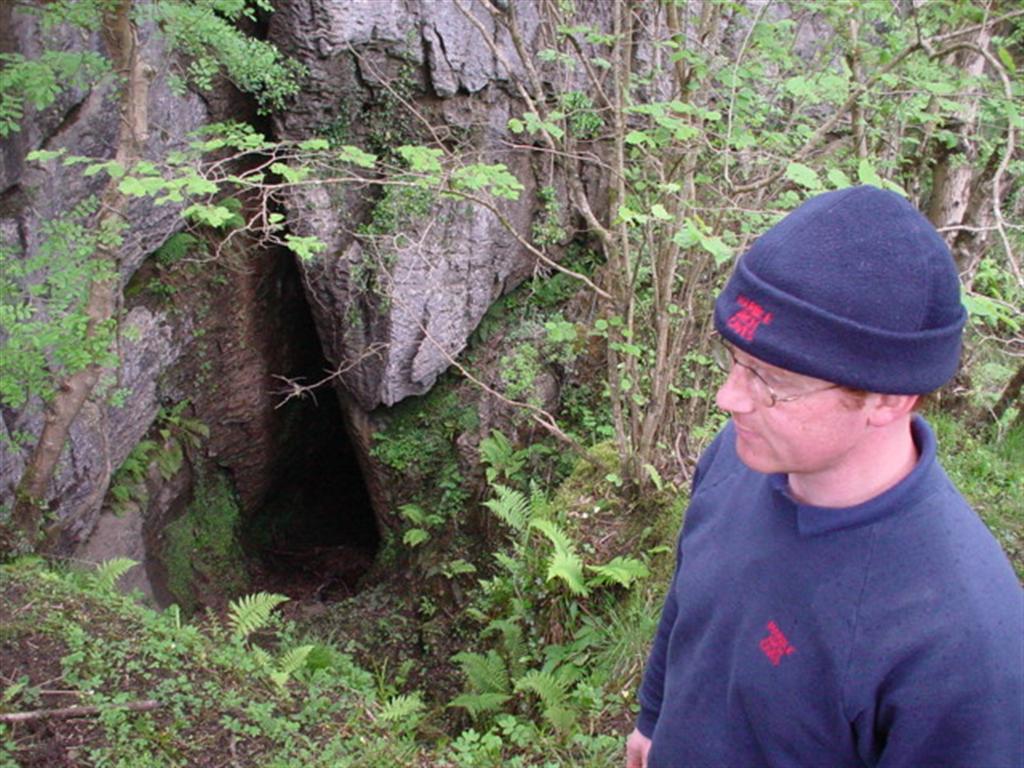 |
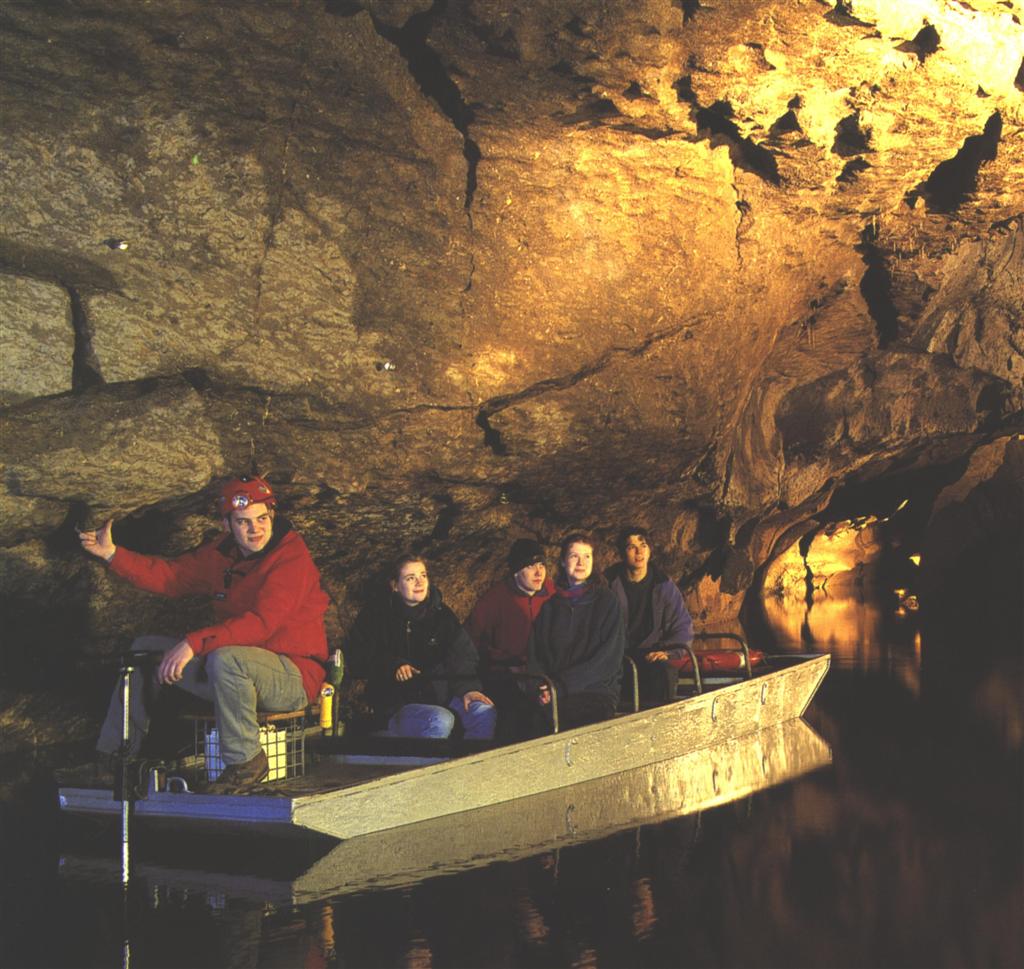 |
Kent Henderson with Richard Watson at Marble Arch Caves |
Connor Burns at the Cladagh River sink, Marble Arch Caves |
The boat trip in Marble Arch Cave Photo: Connor Burns |
Marble Arch is a river-fed cave of great quality, and the system itself is currently surveyed at over 6.5 kilometres in length. As I have described the cave in detail previously I will not greatly iterate here (Henderson 1997). The tour starts with an underground boat trip through its 'wet entrance' down a section of the river, before one alights onto solid ground. As the cave had recently flooded (as it is want to do on occasions) during my previous visit in 1997, I did not get to 'float underground' on that occasion. Happily, I had the opportunity this time. The boat trip is not too dissimilar to the Waitomo Glowworm Cave experience in New Zealand (minus the glowworms), and the boats themselves not dissimilar also. Aside from the water levels, little had altered in the cave since my last visit, and Richard and I discussed management issues at some length.
Two things were of particular interest. Marble Arch has relatively recently been inscribed as a European Geopark, the only show cave site thus far so recognised. Again, I could dilate at length on this matter, but see: http://www.europeangeoparks.org
In terms of Marble Arch Caves, aside from the both the additional environmental protection and commercial/tourist exposure the Geoparks listing brings, it also assists in opening the door to potentially substantial capital funding from the European Union. Indeed, Richard is in the process of pursuing significant funding for a complete re-lighting of the cave. While the current lighting is adequate, certainly a state-of-the-art system would upgrade the cave from reasonable to outstanding. The potential of the cave is very great indeed. I did expound to Richard (at length!) the virtues and skills of our own Neil Kell. I have put them in touch, and it is not impossible that Neil will be called on to consult on the matter.
After a pleasant lunch back at the cave's Visitor Centre (which has been physically expanded, and very well so, since my last visit), I was taken on a field trip by Connor Burns, Richard's second-in-command. Connor is about as great a karst enthusiast as one can be! We visited a number of local karst sites, and in particular the sink of the Cladagh River several miles away, the resurgence of which flows into Marble Arch just before it's 'wet entrance'. The water levels at the sink are computer monitored, with this information constantly on-line back at the Visitor Centre. In the event of a flood, this gives the show cave about half an hour's notice of any water surge - clearly vital warning if tours are then running. Richard is very keen to attend our next ACKMA Conference in New Zealand, and hopefully he'll bring Connor with him! My grateful thanks to both for a great day!
NEWGRANGE
While in Ireland, I also managed to get to Newgrange, the famed Megalithic Passage Tombs, located about an hours drive north of Dublin, which were completed 500 years before the Pyramids of Egypt! It was built about 3200 BC. The Newgrange 'tomb' is a kidney shaped mound covering an area of over one acre and is surrounded by 97 kerbstones, some of which are richly decorated with megalithic art. The 19 metre long inner passage leads to a cruciform chamber with a corbelled roof.
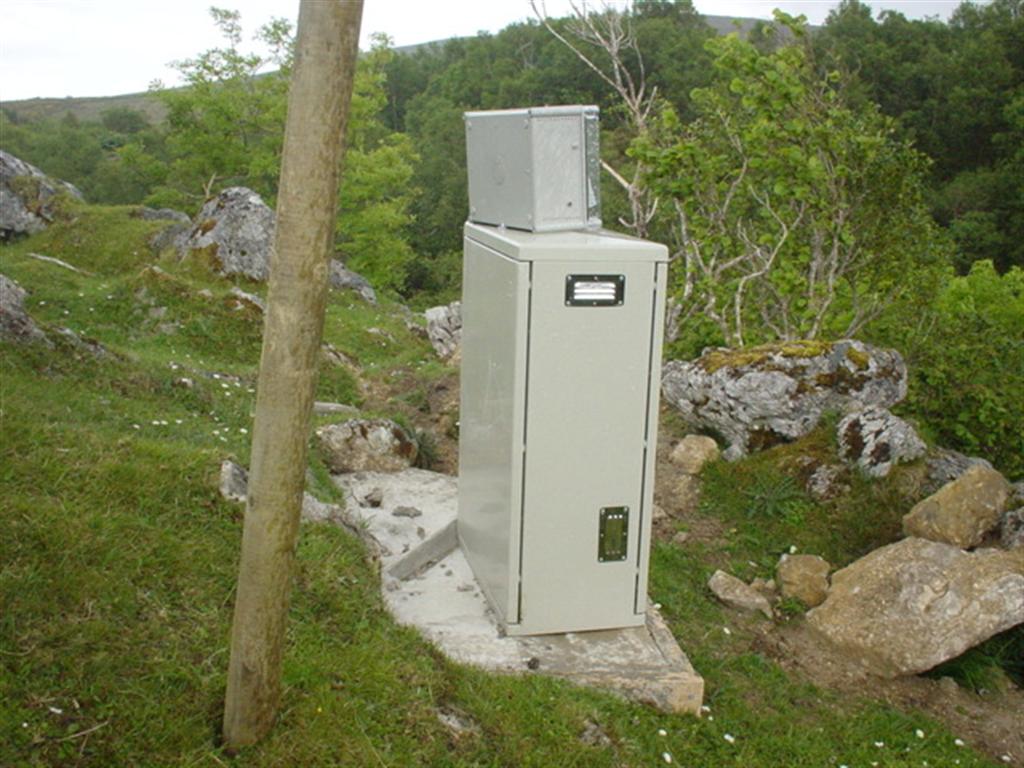 |
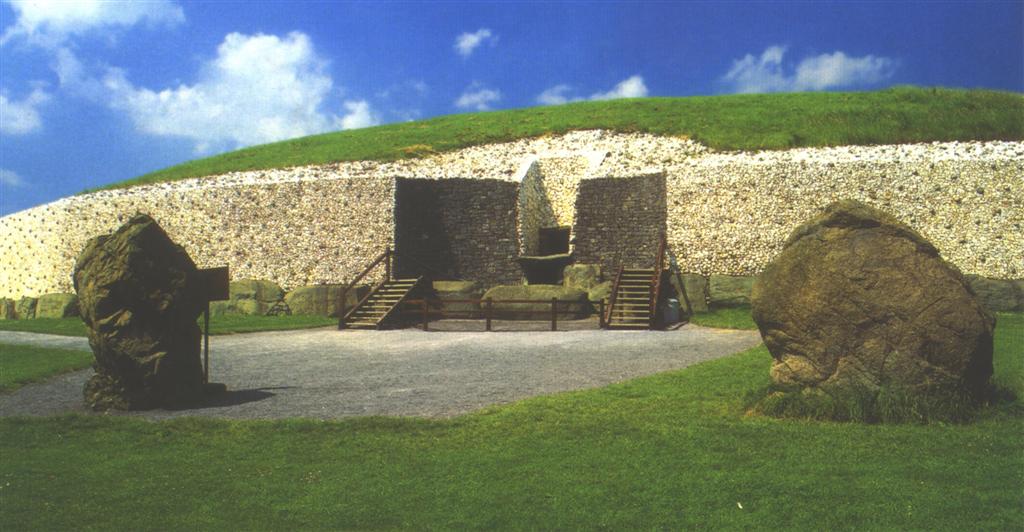 |
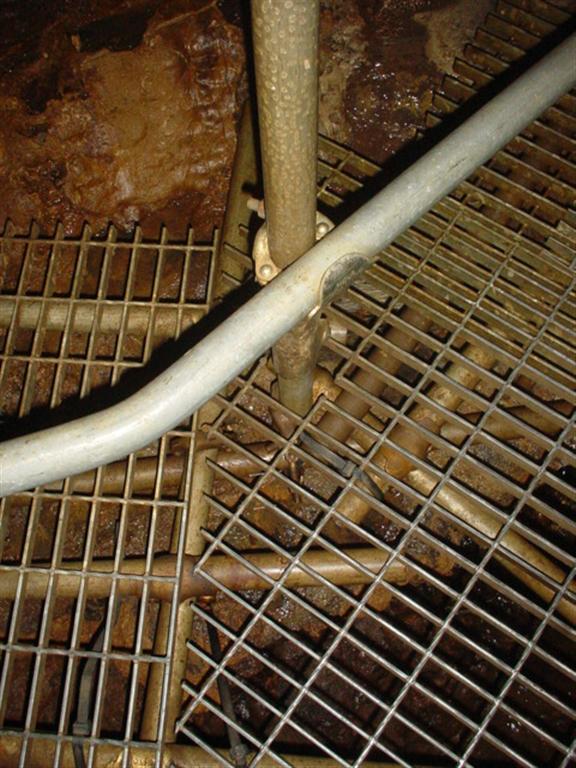 |
Flood level recorder at the Cladagh River sink, Marble Arch Caves |
An external view of Newgrange |
The 'scaffolding' infrastructure in White Scar Cave |
It is estimated that the construction of the Passage Tomb at Newgrange would have taken a work force of 300 at least 20 years. The passage and chamber of Newgrange are illuminated by the winter solstice sunrise, when a shaft of sunlight shines through the roof box over the entrance and penetrates the passage to light up the chamber. This event lasts for 17 minutes at dawn, from the 19 - 23 December. I enjoyed an excellent tour, which was very well interpreted. See: www.knowth.com/newgrange.htm
GIANT'S CAUSEWAY
Additionally, I also got briefly to the 'Giant's Causeway' on the north coast of Ireland - an incredible basalt geological feature, which is World Heritage listed. Sixty million years ago County Antrim was subject to intense volcanic activity. When the lava got to the coast its rapid cooling, combined with variations in the cooling rate, resulted in this world famous columnar structure. The columns are mainly hexagonal though there are some with up to eight sides. Fascinating stuff! See: www.giantscausewayofficialguide.com/welcome.htm
INGLEBOROUGH CAVE
Over in Northern England, again in a hire car, I got to five sites over a few days. The first I visited was Ingleborough Cave at Clapham in the Yorkshire Dales. Once one reaches the delightful little Clapham Village, you have about a two mile forest walk, past a sizable lake, to get to the cave - up hill most of the way. I rather thought this approach (you either walk or you don't go) might significantly affect visitation, though I was later told it didn't. I remain unconvinced, clearly numbers would be higher if the walk was two feet rather than two miles. Still, a very pleasant stroll it was.
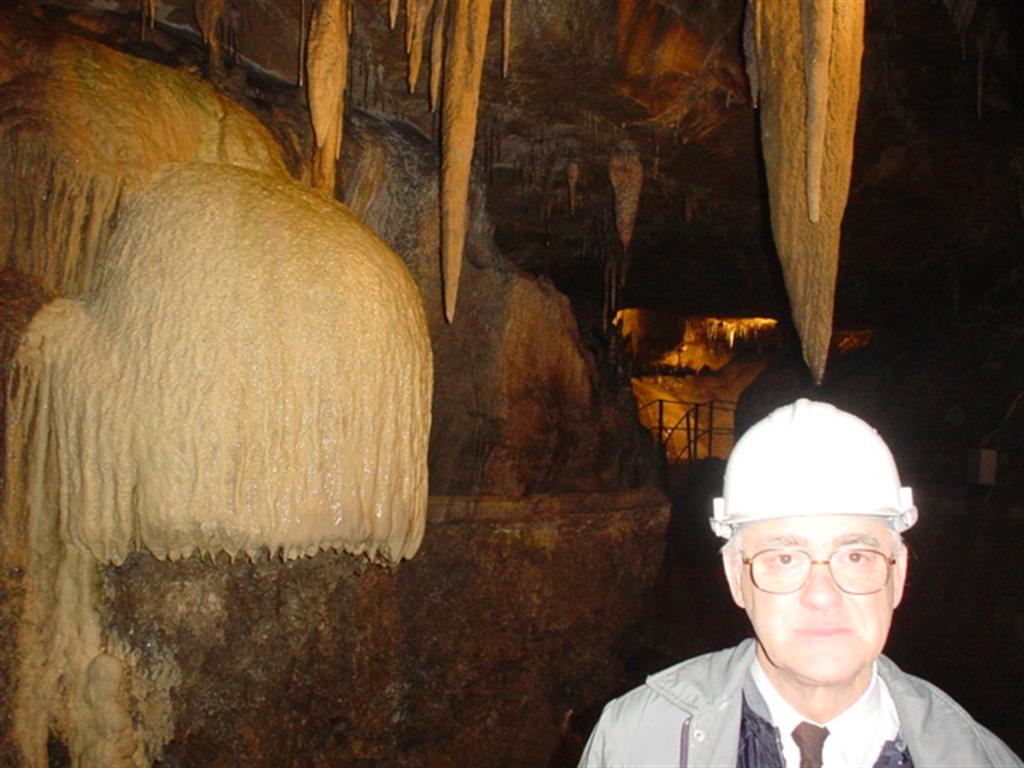 |
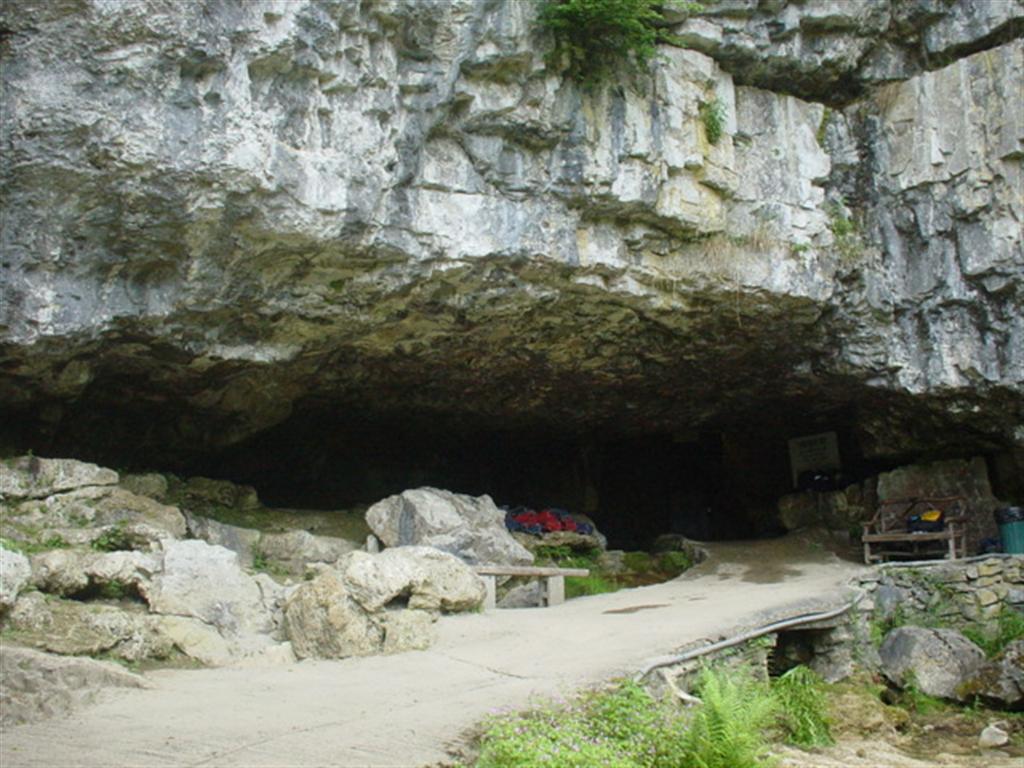 |
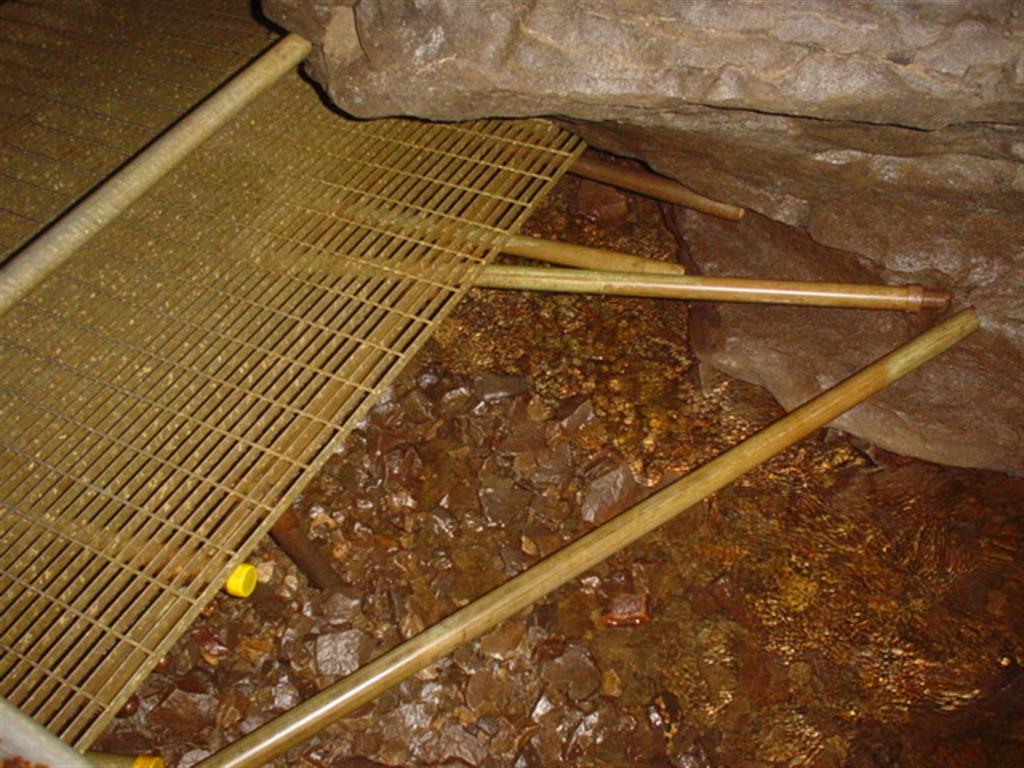 | |
Bob Jarman in Ingleborough Cave |
The entrance to Ingleborough Cave |
The 'scaffolding' infrastructure in White Scar Cave | |
Ingleborough is a fascinating cave. It lies within Ingleborough Mountain, one of the famous 'Three Peaks' of the Yorkshire Dales National Park, which is reportedly extremely cavernous. The external landscape was formed into its current arrangement through glacial action during the Ice Ages. High on this mountain the 'Fell Beck' watercourse sinks into Gaping Gill Pothole with Britain's highest waterfall, with its efflux in the known cave system 1.5 km inside the mountain, after a drop of 110 metres in altitude. The streamway then flows through the cave, before discharging into the valley below.
500 metres of passage from the entrance comprise the show cave, which is subject to occasional flooding, and for most of its length the stream is present. The cave was discovered in 1837. The literature I have doesn't indicate when it was first lit - although my observations would suggest the latest lighting to have been installed within relatively recent times.
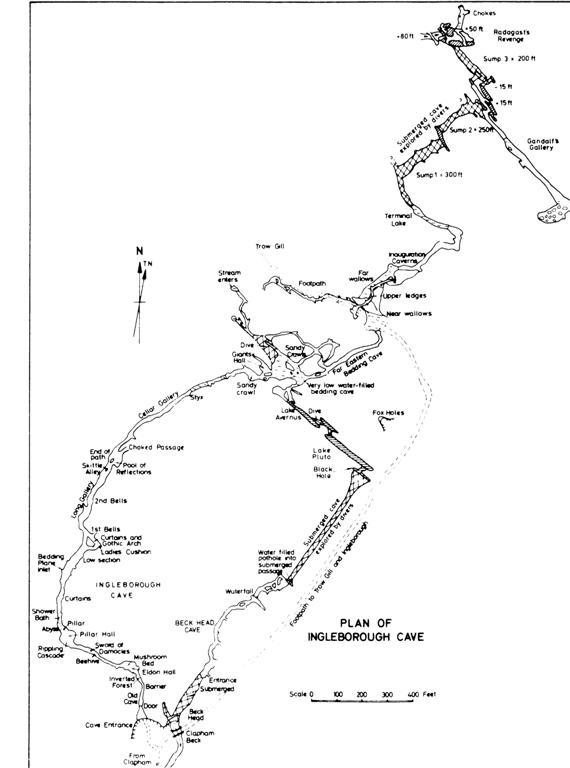
Diagram of the Ingleborough Cave System
Of all the caves I had seen in England to this point (which is most), Ingleborough was undoubtedly the most interesting, both geologically, and in terms of its quality as a show cave, and in its management. Overall, it is one of the 'best of a bad bunch'. The secondary deposition in the cave is outstanding, and while not quite of the same quality, it is nonetheless reminiscent of Croesus Cave at Mole Creek in Tasmania. Superb flowstone and gours is definitely a very great feature.
That said, the development of cave is not good, to say the least. For the most part, to gain tourist access, the right half of the streamway has been concreted.
In addition, this has been achieved, in places, over the top of pristine flowstone. Such would not happen in Australia today (though I'm not so sure about England ...) where it would be seen as wonton vandalism.
Still, to be fair, this 'development' occurred many years ago, long before modern standards were set. The lighting is 240V, with very little switching, and fittings are mostly powerful parafloods. In common with most (if not all) English caves, lampenflora is widespread, and again, as would appear common, no mitigation is seemingly carried out.
I latched onto a tour of secondary school students, led by Bob Jarman, whom I later discovered was the manager/owner of the show cave operation. Bob is a late-aged Yorkshire man of board accent, and based on my many previous 'fairy castle' interpretative experiences (I use the term very advisedly) in England, I wasn't expecting overly much. But I was most pleasantly surprised!
Bob produced a thoroughly informative and educational experience. His imparting of the geology, history and heritage of the cave was excellent. He had a no fuss, yet engaging, style and drew much information out of the students through questions and answers.
I will not say it was the very best cave tour I've ever been on, but it was certainly right up there. His grasp of the geology was impressive. Yes, there were some "fairy castle" bits, but they were mercifully quite few, and not totally out of place given the rest of his interpretation.
I had a good chat to Bob after the tour, and my impression of his enthusiasm and dedication to the cave increased further. Once again, as I had been many times before in England, I was struck by the lack of a comparable organisation to ACKMA in Britain, and what such could achieve for dedicated people like Bob - who has, clearly, risen above the mediocrity of the profession that surrounds him.
There does exist the British and Irish Association of Show Caves, which meets annually, but this organisation is essentially only an economic pressure group - bearing in mind that almost all British Show Caves are privately owned and/or managed.
WHITE SCAR CAVE
After leaving Clapham, I then travelled further across the Yorkshire Dales to Ingleton, to visit White Scar Cave. I arrived late afternoon, and joined the last tour of the day.
White Scar is another efflux stream passage cave, and is one of the worst developed, worst interpreted caves I have ever had the misfortune to inspect.
Where to start? The cave was discovered only in 1925, and thus was not subject to the 'centuries of inadvertent abuse' that have been the bane of many other English and European cave sites - but it might as well have been.
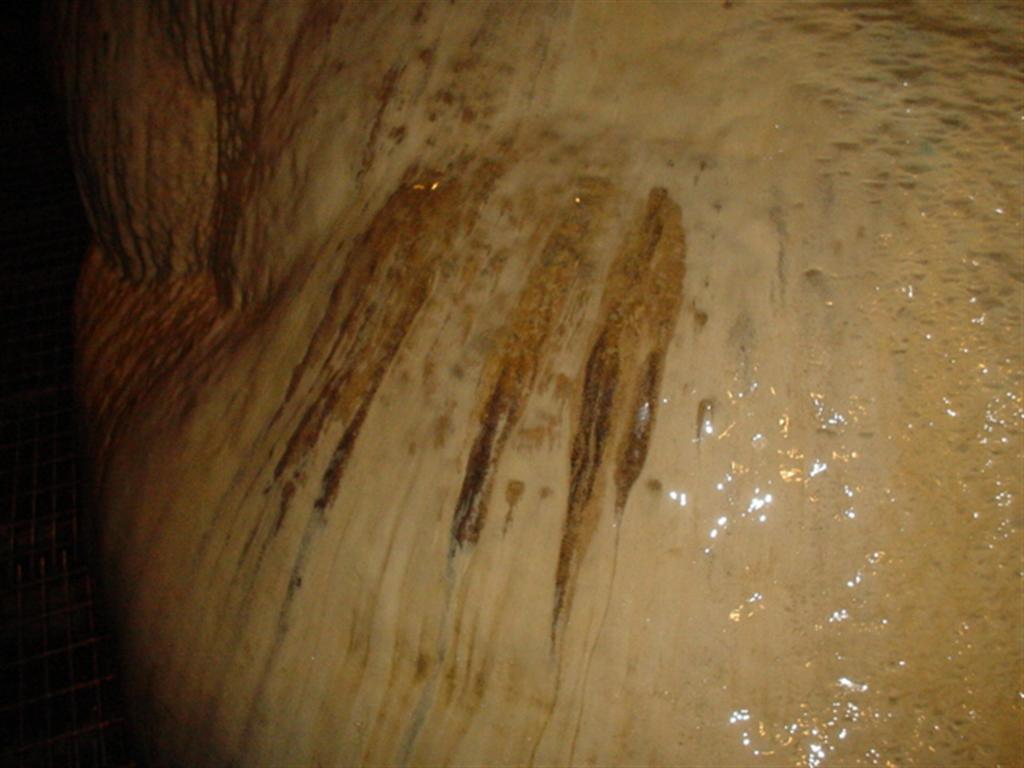 |
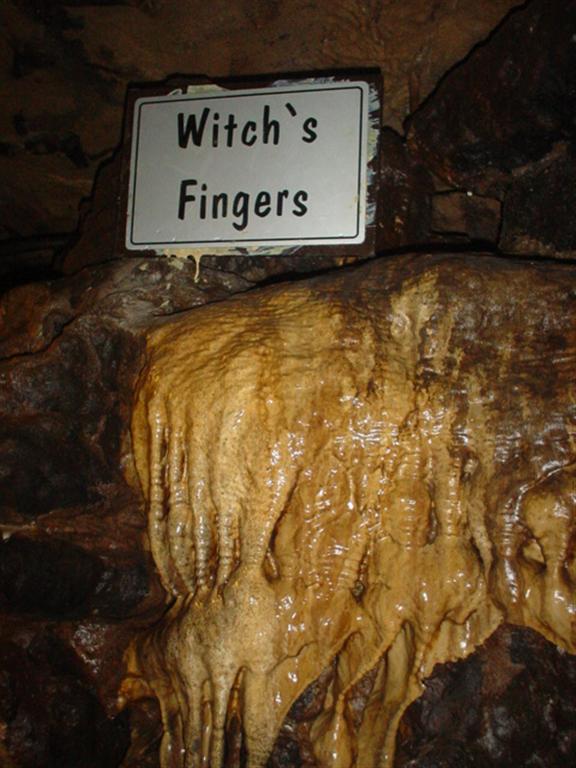 |
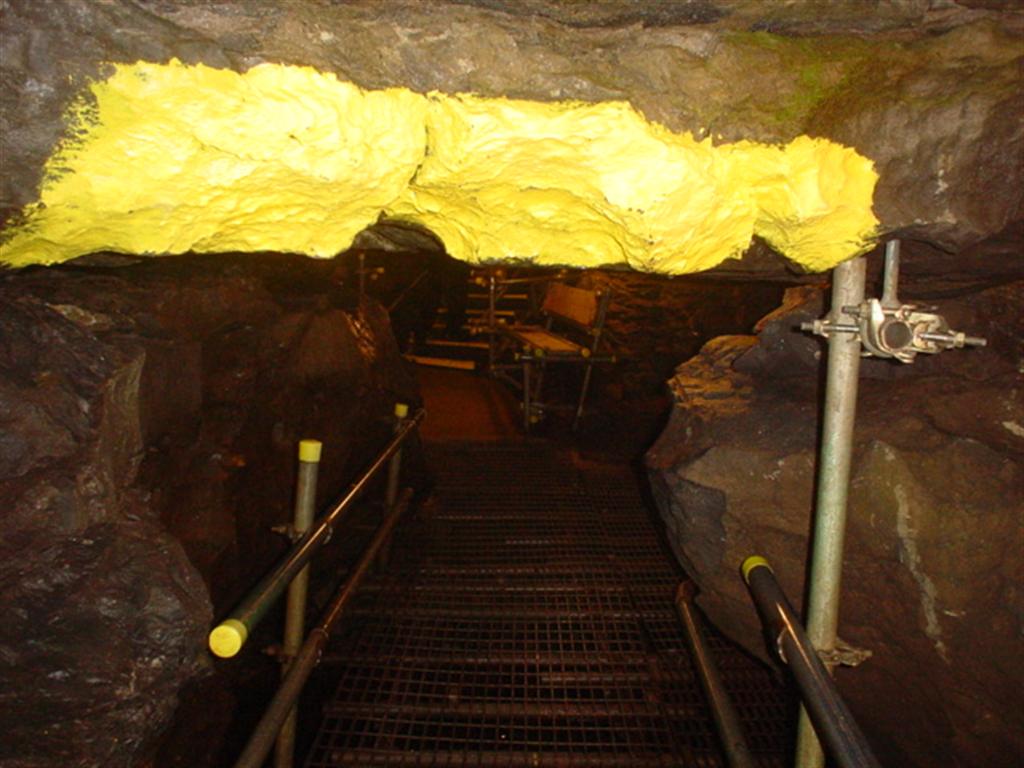 |
Flowstone permanently marked by fingers |
The 'witch's fingers', |
Yellow painted rocks, White Scar Cave |
Yorkshire coal miners mined the entrance passage, around 130 metres, in the late 1920s, soon after its discovery. After traversing this adit, past a dummy one is told represents the discoverer of the cave, one enters the stream passage - some 400 metres of which are toured. As the cave has historically been subject to flooding (and still is), the stream passage section does not possess overly much secondary deposition, though there is a bit.
The infrastructure is appalling. The tracking consists of steel mesh laid above the (mostly) quite narrow stream passageway, which has been fixed into the walls and ground in the most haphazard manner imaginable. The cross-members consist of steel tubing that has been lashed together as one would scaffolding on a building site. It is a jumbled mess, and is the worst possible eyesore. Whoever 'designed' and installed it needs to be symbolically 'shot at dawn without a trial'. I was appalled. Admittedly, steel grills for the raised pathway are probably necessary given the propensity for the passageway to flood, but given you were going to develop it as a show cave (and I seriously doubt it should have been), then undoubtedly an infinitely better job could have been achieved.
But it gets worse. In only 1991, the tourist section was extended. About another 150 metres of stream passage was added to the tour, and a further tunnel cut at its end to link it to the 'Battlefield Cavern'. I'll return to the latter shortly. The 'new' passageway was given the same outrageous infrastructure as the 1920s section - except that in one place where the streamway is mercifully (but unfortunately) wider, instead of continuing around a bend for a short section with the 'scaffolding' it was deemed easier to vandalise half the streamway at that point with a concrete track!
The lighting in the streamway is 'on-all-the-time' 240V parafloods, and given the relative constriction of the passage, lampenfora, totally unchecked, is rampant. Additionally, in a number of places where the ceiling is lower, obtruding rocks have been painted bright yellow (!!!) to assist visitors in not bumping their heads. Absolutely sickening. In common with a number of other English show caves, visitors are given hard hats to wear before entering. Probably a good idea in this case, along with blindfolds.
And then we get to the interpretation, or rather the lack of it. Not to put too fine a point on it, I experienced, without doubt, the worst tour I have ever had the misfortune to encounter. The guide's single contribution to visitor's knowledge of the cave environment was to explain the difference between a stalactite and a stalagmite. The rest of the tour was taken up with the Witch's Fingers, the Buddha, the Devil's Tongue - I'm sure you get the picture. And just to ensure the guide didn't forget to stop at each of these decorative wonders, the name of each formation was on a sign attached to it - in many cases calcified in place.
But there's more horror to convey, I'm sorry. Shortly into the tour, the guide stopped at a bit of flowstone, rubbed his fingers over it vigorously, and then explained to the tour that this action blackened the decoration (having just done so!). Up until that point nobody had touched anything (even though there was no prohibitive statement at the start of the tour, as we would do), but the guide now happily watched while all on the tour (except me) ran their fingers over the same flowstone. For the rest of the tour, the group touched anything they could get their hands on. In one place I noted some excellent flowstone devastated by black finger marks, being now calcified into eternity. I have rarely been so angry in a cave. I did make several pointed remarks to the guide, but I might as well have been speaking in Latin.
We now come the crescendo of the tour, the 'Battlefield Cavern'. This was opened in 1991, after a Cornwall mining company drove a 65-metre tunnel into it. Nearby is an underground lake (not on the tour). Some cavers whom I met the next day at Stump Cross Cavern informed me that most of the excavated rock from the tunnel was tossed into this lake, and that this has (not surprisingly) seriously raised the frequency of flooding in the streamway section.
Halfway up the new tunnel is a sealed door, not there as I immediately assumed to mitigate airflows, but because 'Battlefield Cavern' has excessive radon levels. We were also advised, upon my questioning, that a borehole was cut into the cavern from above to assist radon diffusion. The effect of this on the cave climate is axiomatic, of course.
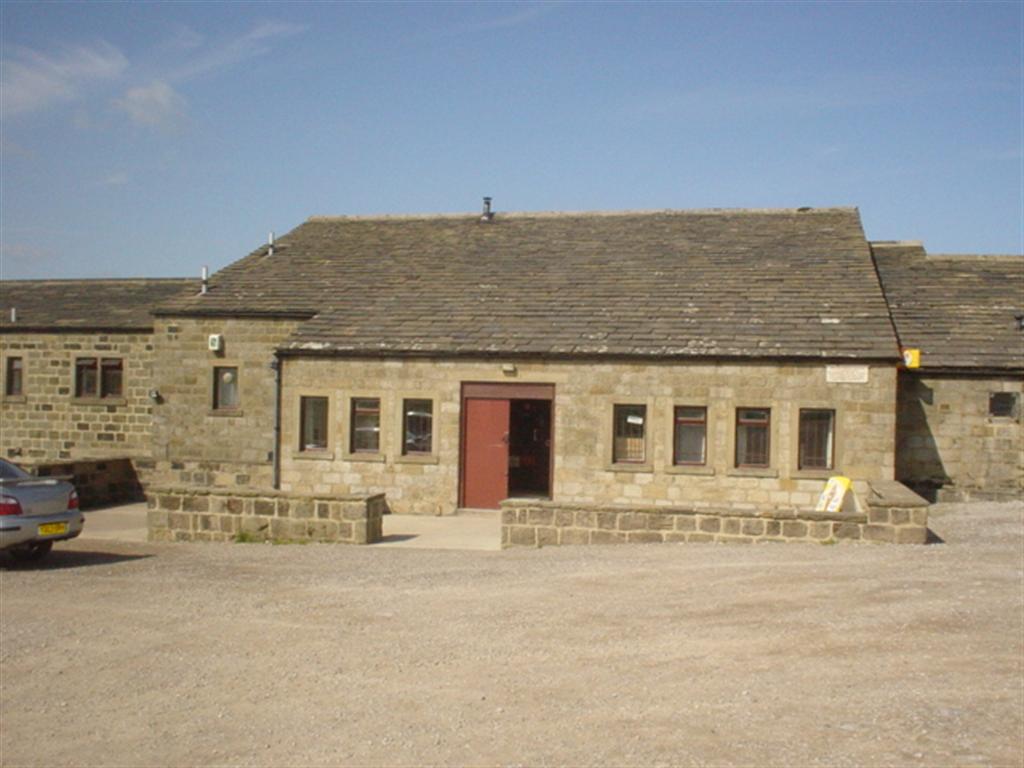 |
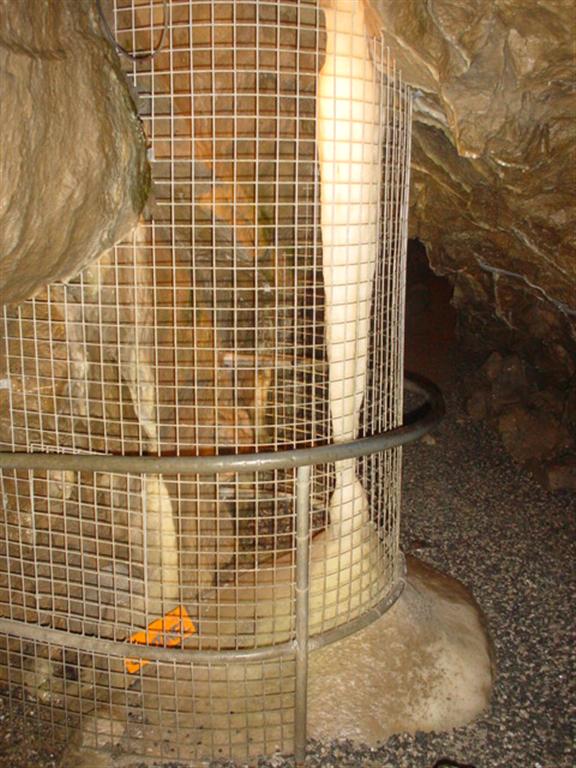 |
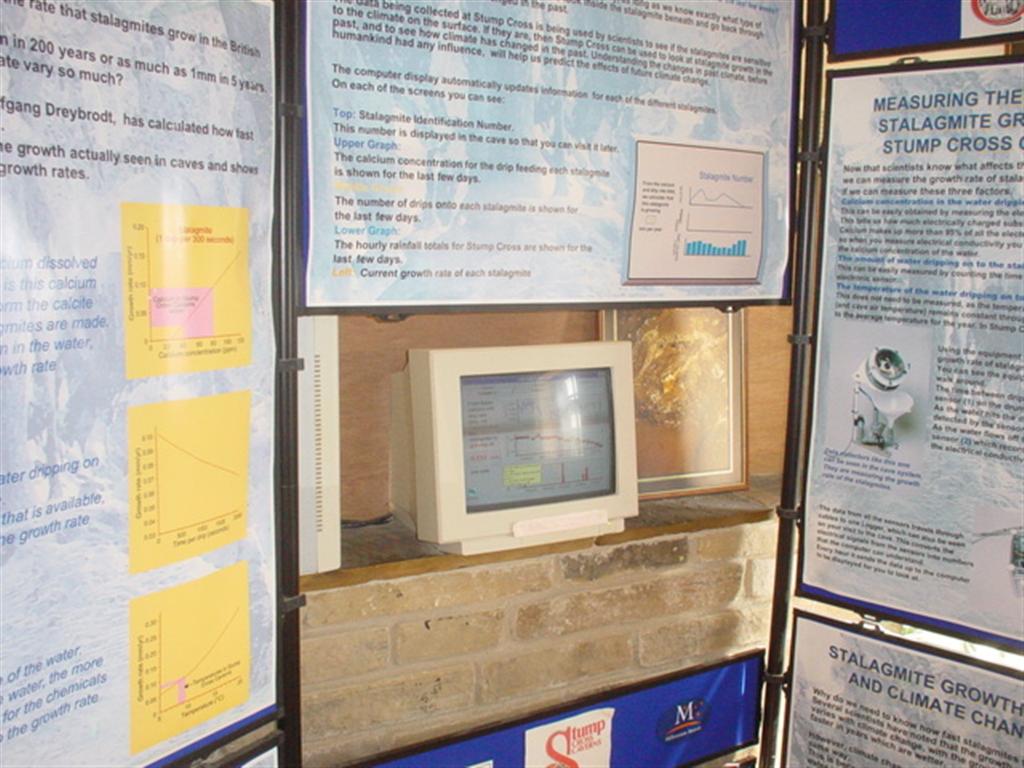 |
The Visitor's Centre, Stump Cross Cavern |
Decoration protection, |
Interpretive Area, Stump Cross Cavern |
So to 'Battlefield Cavern' itself. Why the name is unclear. Perhaps just because it is big? - which it certainly is. Maybe 'battlefield' is a tacit acknowledgement of the cave owner's attitude to management? I could be easily convinced ... It is quite an impressive chamber, particularly given its huge array of long straws. Raised walkways and platforms have been placed through it - the fact that the tracking was raised is good - although using the same appalling 'scaffolding' as in the streamway section.
Presumedly because the raised tracking is above perceived flood levels, instead of the wire steel grill flooring used elsewhere in the cave, in this section (mostly) wooden floorboards have been used. As the cavern is quite active, the wood flooring is constantly wet, and slippery as a result. I was (marginally) happier with the lighting in 'Battlefield Cavern', which wasn't overly lit, and the fittings mostly concealed. That said we had to, for some reason, have ultraviolet lights turned on the straws at one point!
The egress from the tour was to retrace our footsteps to the entrance, after the worst designed, managed and 'interpreted' cave experience I have ever suffered. I was advised later that the owner of the cave lives in London, and never visits - evidentially it is but a 'cash cow', which is appallingly obvious. I was also later advised that White Scar Cave has been tossed out of the British and Irish Association of Show Caves. I am not sure why, but I can guess.
STUMP CROSS CAVERNS
And so to a happier experience! Still in the Yorkshire Dales, my next port of call was Stump Cross Caverns, back towards Harrogate. It possesses an excellent visitor's centre, and a good (though not large) interpretative display area. I arrived first thing in the morning, and met the owner/manager Gordon Handley, who warmly welcomed me. Lead miners discovered the cave in 1860, and it was opened as a show cave in 1863. Happily, it has always been quite well protected. Over six kilometres of passage have so far been surveyed in the system, but only a small section forms the show cave.
The cave is self-guided - I suspect for economic reasons - and visitors are given a hard hat at the entrance, and pointed down the stairs. The cave has two main branches, totalling about 150 metres. As a result of its 'self-guiding', decoration in the cave is heavily protected with wire grills. Unfortunately, key formations are named with signs, concreted in situ, often on top of flowstone. Not good, to say the least, but this was done many years ago well before the current owner's era. Unfortunately, removing the signage would probably cause more damage than leaving it there, so it will need to stay as an historic curiosity, sadly. Lighting in the cave is adequate, but with no switching, and thus significant lampenflora.
I had a lengthy discussion with Gordon after my tour about the possibility of using backlit interpretative signage and infrared trip lights, which would certainly work well in this particular cave. He was quite amenable to the idea, but I also discovered he has the cave on the market for sale ...
A final section of the tour, the 'Reindeer Cavern' was only opened to the public a few years ago. This chamber is relatively large, and profusely decorated. It has also been superbly lit. One looks into the chamber from behind a wire grill - you do not enter it. That this cavern is not entered is, in my view, quite appropriate, although the 'wire wall' certainly does not make for good viewing.
I suggested to Gordon a glass wall, with a built in demister system (like the back windscreen of a car) might be worth looking at, and he liked that idea too. Again, this highlighted to me yet again how insular English cave management is, through no fault of any individual. Certainly, scientific input, and caver input, is there for the asking, but in terms of nitty gritty cave management and cave conservation very little, sadly (outside the economics).
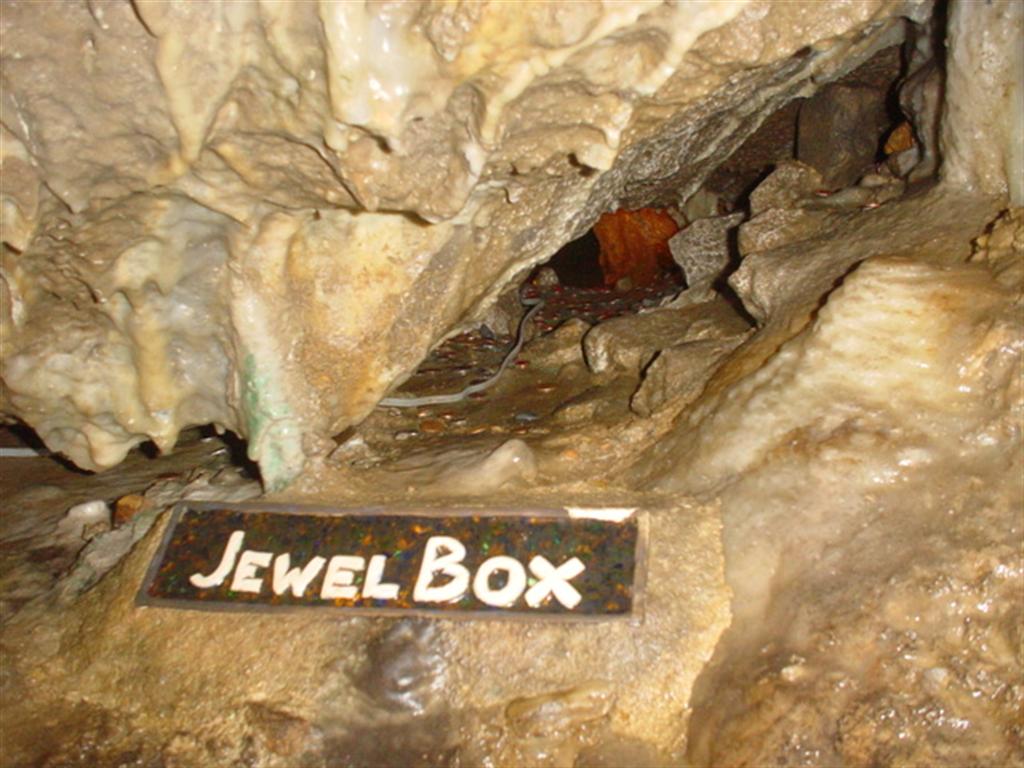 |
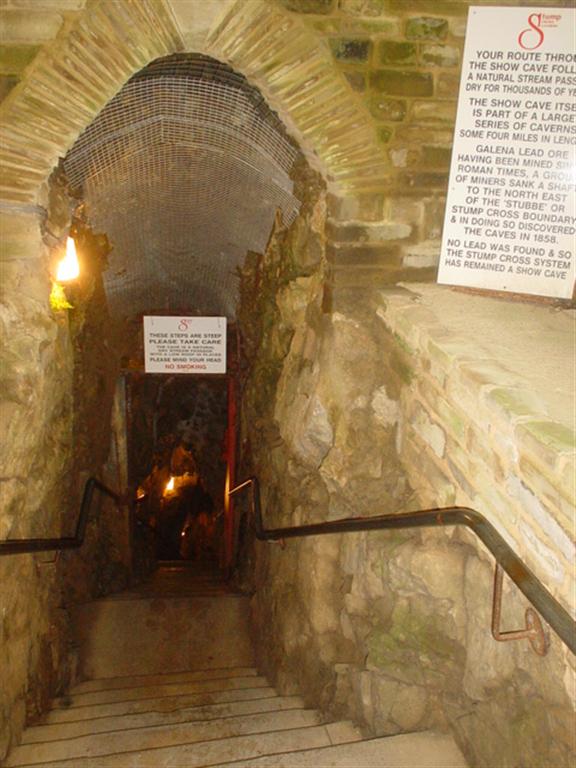 |
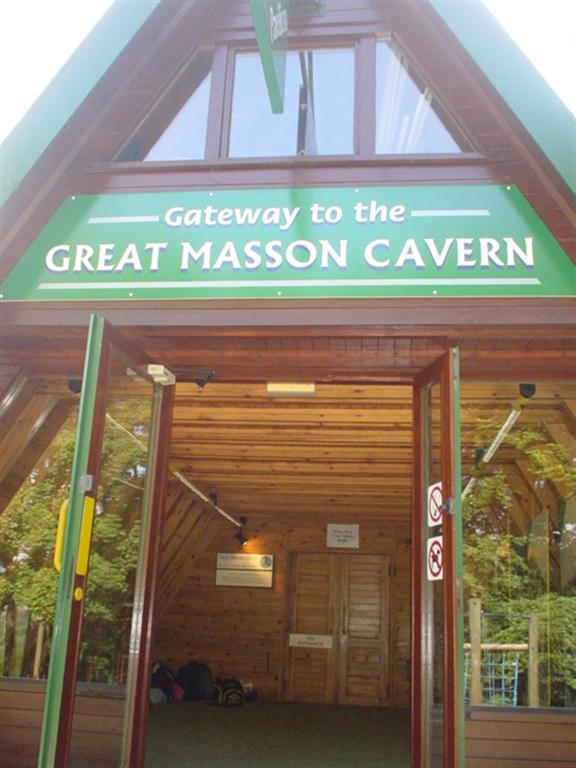 |
Unfortunate Signage, Stump Cross Cavern |
The entrance tunnel, |
Entrance area, Great Masson Cavern, |
After completing the tour, one then enters an auditorium for a ten-minute video on the cave, which is quite well done. Though, in my view, it would be better shown to visitors before they undertake the tour, so they have an idea of what they are to see, as interpretation in the cave is largely lacking - hence my suggestion for backlit panels. Just a descriptive brochure, as one enters, would be a good start ...
The other thing that impressed me about Stump Cross is the scientific work occurring in the cave. A large amount of work in dating stalagmites and identifying and dating pollens has been done in the cave in recent years. Data loggers are currently in the cave measuring drip rates. A computer monitor, as part of the interpretation in the Visitor's Centre, allows the public real time viewing of the data, showing how much calcium is dissolved in drips, and the drip rate. All very good stuff indeed.
Overall, Stump Cross is one of the better English show cave experiences - far from perfect, but with much potential.
THE HEIGHTS OF ABRAHAM
I then meandered down to Derbyshire to the 'Heights of Abraham', which is south of Manchester, just to the north of Derby, at the town of Matlock Bath. The town sits in a pleasant karst valley, with quite high limestone hills/walls on its sides. The 'Heights of Abraham' is a local tourist attraction largely reached cable car. The ride gives one a stunning view over the town and surrounding terrain. At the top is a visitor's centre, shops, and two show caves - of sorts.
I only had time to visit one, which was the 'Great Masson Cavern'. The cave is largely man-made, in that it is an old and quite extensive lead mine, though it does have some natural limestone sections. One would hardly know it was largely 'not natural' unless told. It is, not surprisingly, almost totally devoid of decoration. It is well enough lit, I suppose, if you like full on para floods.
The tour commenced with a brief video, followed by half an hour underground. My young guide was pretty bored, unenthusiastic and clearly sparsely rehearsed. Her knowledge was not good. She mentioned, and pointed out, calcite on a few occasions, but when I asked her if there was any limestone in the cave (naughty me!) she replied she didn't think so! Oh dear ... A very ordinary 'cave', and a very ordinary tour. I don't suggest you rush out ... I understand the other 'cave', the 'Great Rutland Cavern', is purely an old lead mine, festooned with old equipment and memorabilia from that bygone era. I haven't lost any sleep from missing it. The cable car ride back was good though!
THE CRESWELL CRAGS
My final karst experience of the trip was to visit the Creswell Crags, part of the Creswell Limestone Heritage Area, which runs through South Yorkshire, North Nottinghamshire and North East Derbyshire, to the east and south east of Sheffield. It consists of five sites, with walks at each ranging from four to eight miles. I only had time to visit one of these sites, the Creswell Crags, which is replete with a relatively small, though excellent, Visitor's Centre.
The Creswell Crags walk consists of the circumnavigation of a track around a delightful little karst valley, with a lake in the middle, and limestone bluffs on each side. The trip around the lake takes about half an hour but there is an extended walk of seven miles, which I didn't do.
The pathway is graded, with lots of excellent interpretive signs en route. At various places along the track are cave entrances, all gated, and all well interpreted. The caves themselves are not long, and the main focus is on prehistoric man.
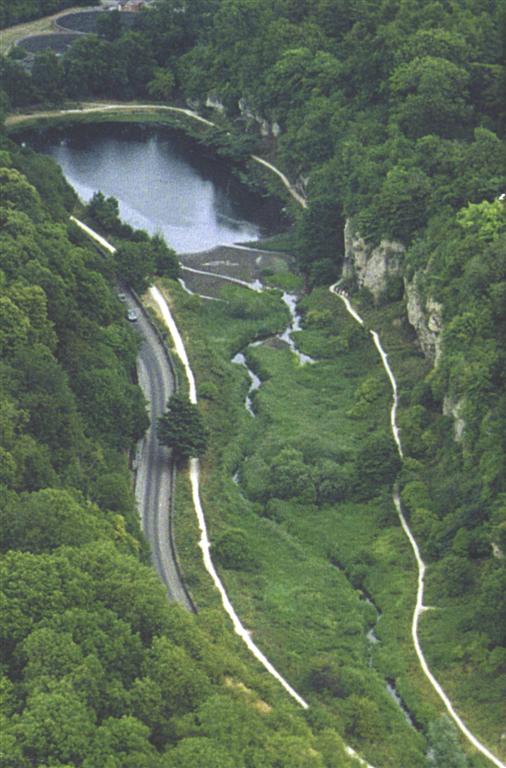 |
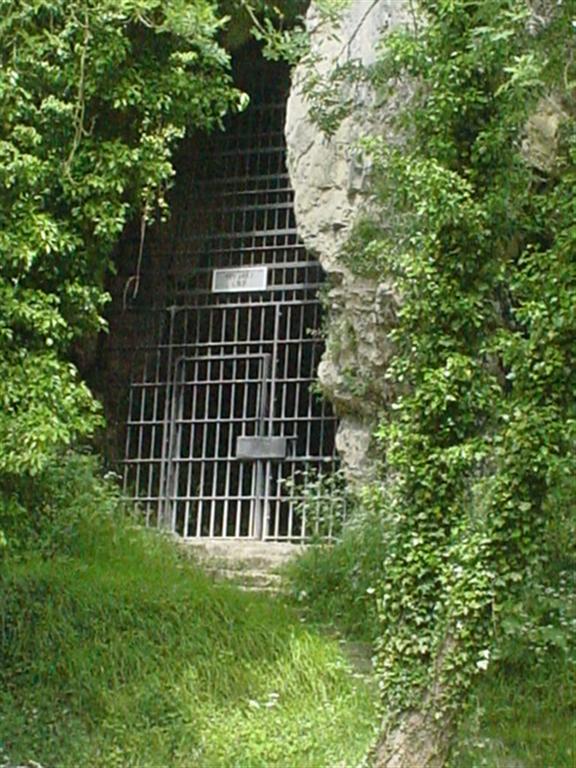 |
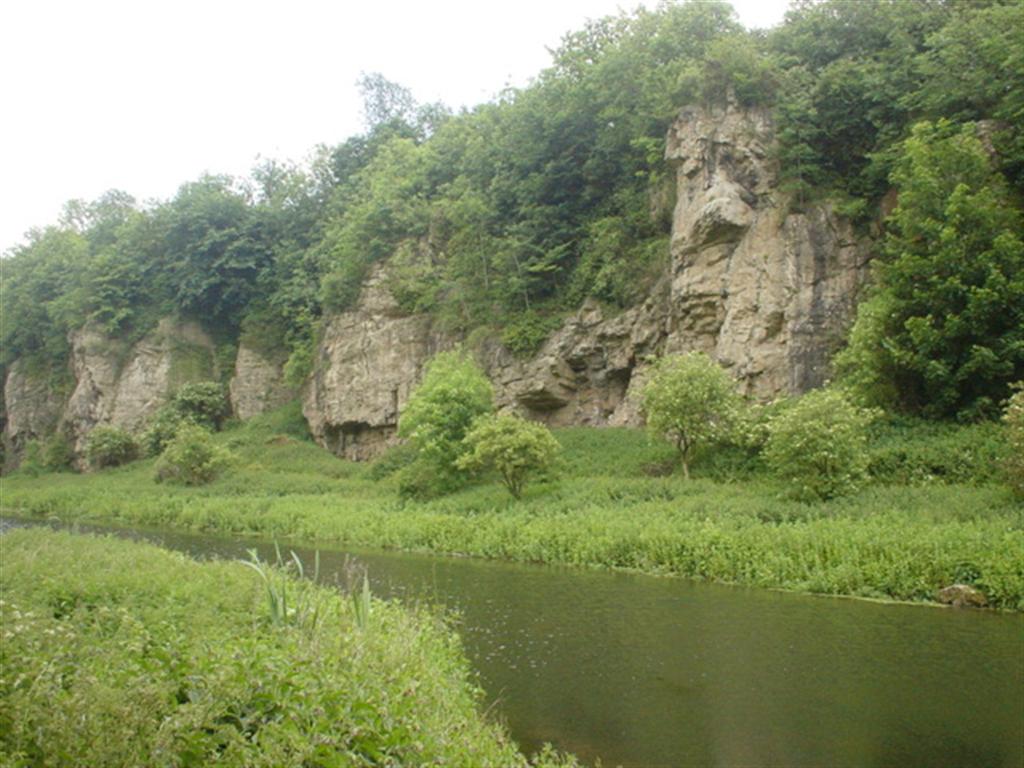 |
 |
An aerial view of |
A gated cave entrance, |
A view of the limestone walls at Creswell Crags |
An example of the excellent interpretative signage at Creswell Crags |
A great deal of archaeology, still ongoing, has occurred in the caves and the wider area. Tours to one of the caves, 'Robin Hood Cave', are run on weekends - of course, I was there on a Wednesday. Sigh ...
Evidently, the half hour tour (helmets and lights provided) goes in only 50 metres to view archaeological diggings. The Visitor's Guide one gets before the walk is excellent, and the whole karst experience is most satisfactory indeed.
In summary I was very impressed with the whole area, and its interpretation. It was great to see something karstic in England done well for a change! In addition, the booklet one can obtain on the wider Creswell Limestone Heritage Area is also excellent, and definitely worth buying.
REFERENCES
Henderson, K W. (1987) Tourist Caves in Europe - A Comparative Study. Proceedings of the Seventh Australasian Conference on Cave & Karst Management, New South Wales. pp 1-3.
Henderson, K. W. (1993) Management of Selected English and Irish Caves. Proceedings of the Tenth Australasian Conference on Cave & Karst Management, Rockhampton, Queensland. pp 1-2.
Henderson, K. W. (1997) Cave Management in Ireland. ACKMA Journal No 29, December 1997. pp 4-13.